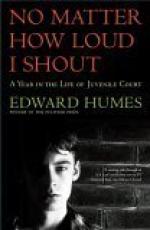
|
| Name: _________________________ | Period: ___________________ |
This test consists of 5 multiple choice questions, 5 short answer questions, and 10 short essay questions.
Multiple Choice Questions
1. According to the evidence presented in Part 1, Chapter 5, John Sloan met what friend outside the department store where he worked on the day of the crime?
(a) Paul.
(b) Richard.
(c) Johnathan.
(d) Jason.
2. In Elias’s poem from “Intake,” he described turning a Walkman’s motor into what?
(a) A taser.
(b) A drill.
(c) A gun.
(d) A tattoo machine.
3. Who is described as wielding “as a kind of pretrial judge, jury, and jailer rolled into one” in “Intake”?
(a) The Intake Officer.
(b) The Warden.
(c) The Mayor.
(d) The head psychologist.
4. Where did the author describe Peggy Beckstrand keeping the crime scene photos from the Ronald Duncan trial in Part 1, Chapter 8?
(a) Her desk drawer.
(b) Her jewelry box.
(c) Her bedroom wall.
(d) Her living room table.
5. Where does Geri Vance hide his ongoing autobiography so that it won’t be confiscated at night, according to the author in Part 1, Chapter 4?
(a) Behind the toilet.
(b) Under his rug.
(c) In the windowsill.
(d) Under his mattress.
Short Answer Questions
1. Judge Dorn worked his way through law school working as what, according to the author in Part 1, Chapter 4?
2. What judge is described by the author in Part 1, Chapter 2 as having seen “potential” in Carla James, and thus gave her a lesser sentence for theft and assault?
3. What famously televised court case were the students in the writing class watching in Part 1, Chapter 3?
4. What does HRO stand for in the narrative?
5. How much money had John Sloan paid for the .380 revolver he had, according to the evidence presented in Part 1, Chapter 5?
Short Essay Questions
1. What led to Carla James’s apprehension in Part 1, Chapter 7?
2. What led to George Trevino’s decision to join a street gang, according to the author in Part 1, Chapter 6? How did this lead to his arrest?
3. How does the author describe Geri Vance’s home life growing up in Part 1, Chapter 4?
4. How is Luis Santos described by the author in Part 1, Chapter 6? What was Luis charged with?
5. How does the author describe the DA’s case as revealed in the Duncan trial in Part 1, Chapter 8?
6. How did Judge Dorn’s conflict with the Public Defender’s office begin to escalate in Part 1, Chapter 7?
7. How were Joseph Gutierrez’s actions perceived by the court in Part 1, Chapter 5?
8. How is Elias Elizondo described? What is revealed in Elias’s poem from “Intake”?
9. What was the judge’s decision regarding George Trevino’s “fitness”? Why did the judge reach this decision?
10. For what crime was Carla James charged in Part 1, Chapter 2? How is Carla characterized by the author?
|
This section contains 961 words (approx. 4 pages at 300 words per page) |

|




